Dell OptiPlex 745 User Manual [en, cs, pl]
Dell™ OptiPlex™ 745
Quick Reference Guide
Models DCTR, DCNE, DCSM, and DCCY
w w w . d e l l . c o m | s u p p o r t . d e l l . c o m

Notes, Notices, and Cautions
NOTE: A NOTE indicates important information that helps you make better use of your computer.
NOTICE: A NOTICE indicates potential damage to hardware or loss of data and tells you how to avoid the problem.
 CAUTION: A CAUTION indicates a potential for property damage, personal injury, or death.
CAUTION: A CAUTION indicates a potential for property damage, personal injury, or death.
If you purchased a Dell™ n Series computer, any references in this document to Microsoft® Windows® operating systems are not applicable.
____________________
Information in this document is subject to change without notice. © 2006 Dell Inc. All rights reserved.
Reproduction in any manner whatsoever without the written permission of Dell Inc. is strictly forbidden.
Trademarks used in this text: Dell, the DELL logo, Inspiron, Dell Precision, Dimension, OptiPlex, Latitude, PowerEdge, PowerVault, PowerApp, and Dell OpenManage are trademarks of Dell Inc.; Intel, Pentium, and Celeron are registered trademarks of Intel Corporation; Microsoft and Windows are registered trademarks of Microsoft Corporation.
Other trademarks and trade names may be used in this document to refer to either the entities claiming the marks and names or their products. Dell Inc. disclaims any proprietary interest in trademarks and trade names other than its own.
Models DCTR, DCNE, DCSM, and DCCY
August 2006 |
P/N FH898 |
Rev. A00 |

Contents
Finding Information . . . . . . . . . . . . . . . . . . . . . . . . . . . . . . . . |
5 |
System Views . . . . . . . . . . . . . . . . . . . . . . . . . . . . . . . . . . . |
8 |
Mini Tower Computer — Front View . . . . . . . . . . . . . . . . . . . . . |
8 |
Mini Tower Computer — Back View . . . . . . . . . . . . . . . . . . . . |
10 |
Mini Tower Computer — Back-Panel Connectors . . . . . . . . . . . . . |
11 |
Desktop Computer — Front View. . . . . . . . . . . . . . . . . . . . . . |
13 |
Desktop Computer — Back View. . . . . . . . . . . . . . . . . . . . . . |
14 |
Desktop Computer — Back-Panel Connectors . . . . . . . . . . . . . . |
15 |
Small Form Factor Computer — Front View . . . . . . . . . . . . . . . . |
17 |
Small Form Factor Computer — Back View . . . . . . . . . . . . . . . . |
18 |
Small Form Factor Computer — Back-Panel Connectors . . . . . . . . . |
19 |
Ultra-Small Form Factor Computer — Front View . . . . . . . . . . . . . |
21 |
Ultra-Small Form Factor Computer — Side View. . . . . . . . . . . . . . |
22 |
Ultra-Small Form Factor Computer — Back View . . . . . . . . . . . . . |
23 |
Ultra-Small Form Factor Computer — Back-Panel Connectors . . . . . . |
23 |
Removing the Computer Cover. . . . . . . . . . . . . . . . . . . . . . . . . . |
24 |
Before You Begin . . . . . . . . . . . . . . . . . . . . . . . . . . . . . . |
25 |
Mini Tower Computer . . . . . . . . . . . . . . . . . . . . . . . . . . . . |
26 |
Desktop Computer . . . . . . . . . . . . . . . . . . . . . . . . . . . . . |
27 |
Small Form Factor Computer . . . . . . . . . . . . . . . . . . . . . . . . |
28 |
Ultra-Small Form Factor Computer . . . . . . . . . . . . . . . . . . . . . |
30 |
Inside Your Computer . . . . . . . . . . . . . . . . . . . . . . . . . . . . . . |
32 |
Mini Tower Computer . . . . . . . . . . . . . . . . . . . . . . . . . . . . |
32 |
Desktop Computer . . . . . . . . . . . . . . . . . . . . . . . . . . . . . |
35 |
Small Form Factor Computer . . . . . . . . . . . . . . . . . . . . . . . . |
38 |
Ultra-Small Form Factor Computer . . . . . . . . . . . . . . . . . . . . . |
41 |
Setting Up Your Computer . . . . . . . . . . . . . . . . . . . . . . . . . . . . |
43 |
Set Up Your Keyboard and Mouse . . . . . . . . . . . . . . . . . . . . . |
45 |
Set Up Your Monitor . . . . . . . . . . . . . . . . . . . . . . . . . . . . |
45 |
Power Connections . . . . . . . . . . . . . . . . . . . . . . . . . . . . . |
46 |
Solving Problems . . . . . . . . . . . . . . . . . . . . . . . . . . . . . . . . |
46 |
Dell Diagnostics. . . . . . . . . . . . . . . . . . . . . . . . . . . . . . . |
46 |
System Lights . . . . . . . . . . . . . . . . . . . . . . . . . . . . . . . . |
49 |
Contents 3

Diagnostic Lights . . . . . . . . . . . . . . . . . . . . . . . . . . . . . . |
50 |
Beep Codes . . . . . . . . . . . . . . . . . . . . . . . . . . . . . . . . . |
52 |
Resolving Software and Hardware Incompatibilities . . . . . . . . . . . |
53 |
Using Microsoft Windows XP System Restore . . . . . . . . . . . . . . . |
54 |
Reinstalling Microsoft Windows XP . . . . . . . . . . . . . . . . . . . . |
55 |
Using the Drivers and Utilities CD . . . . . . . . . . . . . . . . . . . . . . . . |
58 |
Drivers for Your Computer . . . . . . . . . . . . . . . . . . . . . . . . . |
58 |
Index . . . . . . . . . . . . . . . . . . . . . . . . . . . . . . . . . . . . . . . . . |
59 |
4 Contents
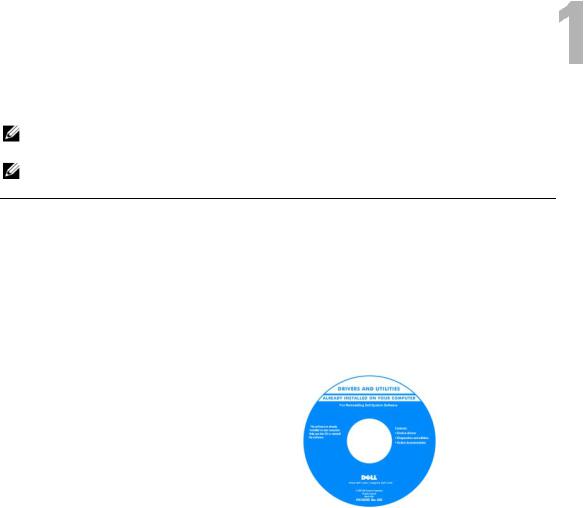
Finding Information
NOTE: Some features or media may be optional and may not ship with your computer. Some features or media may not be available in certain countries.
NOTE: Additional information may ship with your computer.
What Are You Looking For? |
Find It Here |
|
|
• A diagnostic program for my computer |
Drivers and Utilities CD (ResourceCD) |
• Drivers for my computer |
NOTE: The Drivers and Utilities CD may be optional |
• My computer documentation |
and may not ship with your computer. |
• My device documentation |
Documentation and drivers are already installed on |
• Desktop System Software (DSS) |
your computer. You can use the CD to reinstall |
|
drivers (see "Using the Drivers and Utilities CD" on |
|
page 58), run the Dell Diagnostics (see "Dell |
|
Diagnostics" on page 46), or access your |
|
documentation. |
|
Readme files may |
|
be included on your |
|
CD to provide last- |
|
minute updates |
|
about technical |
|
changes to your |
|
computer or |
|
advanced technical |
|
reference material |
|
for technicians or |
|
experienced users. |
|
NOTE: Drivers and documentation updates can be |
|
found at support.dell.com. |
|
|
• How to remove and replace parts |
Dell™ OptiPlex™ User’s Guide |
• Specifications |
Microsoft Windows XP Help and Support Center |
• How to configure system settings |
1 Click Start→ Help and Support→ Dell User and |
• How to troubleshoot and solve problems |
System Guides→ System Guides. |
|
2 Click the User’s Guide for your computer. |
|
The User’s Guide is also available on the optional |
|
Drivers and Utilities CD. |
Quick Reference Guide |
5 |
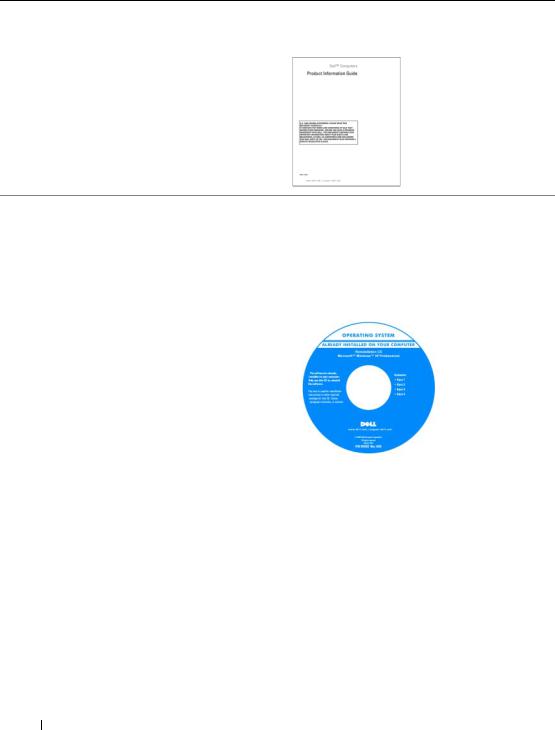
What Are You Looking For? |
Find It Here |
|
|
• Warranty information |
Dell™ Product Information Guide |
•Terms and Conditions (U.S. only)
•Safety instructions
•Regulatory information
•Ergonomics information
•End User License Agreement
• How to reinstall my operating system |
Operating System CD |
|
NOTE: The Operating System CD may be optional and |
|
may not ship with your computer. |
|
The operating system is already installed on your |
|
computer. To reinstall your operating system, use |
|
the Operating System CD (see "Reinstalling |
|
Microsoft Windows XP" on page 55). |
|
After you reinstall |
|
your operating |
|
system, use the |
|
optional Drivers and |
|
Utilities CD |
|
(ResourceCD) to |
|
reinstall drivers for |
|
the devices that |
|
came with your |
|
computer. For more |
|
information, see |
|
"Drivers and Utilities CD (ResourceCD)" on page 5. |
|
Your operating system product key label is located |
|
on your computer (see "Service Tag and Microsoft® |
|
Windows® Product Key" on page 7). |
|
NOTE: The color of your Operating System CD varies |
|
according to the operating system you ordered. |
|
|
• How to use Windows XP |
Windows Help and Support Center |
• How to work with programs and files |
1 Click Start→ Help and Support. |
• How to personalize my desktop |
2 Type a word or phrase that describes your problem |
|
and click the arrow icon. |
|
3 Click the topic that describes your problem. |
|
4 Follow the instructions on the screen. |
6 Quick Reference Guide

What Are You Looking For? |
Find It Here |
|
|
• Service Tag and Express Service Code |
Service Tag and Microsoft® Windows® Product Key |
• Microsoft Windows Product Key Label |
These labels are located on your computer. |
|
• Use the Service |
|
Tag to identify |
|
your computer |
|
when you use |
|
support.dell.co |
|
m or contact |
|
support. |
|
• Enter the Express Service Code to direct your call |
|
when contacting support. |
• Solutions — Troubleshooting hints and tips, articles |
Dell Support Website — support.dell.com |
from technicians, online courses, and frequently asked |
NOTE: Select your region or business segment to |
questions |
view the appropriate support site. |
• Community — Online discussion with other Dell |
|
customers |
|
• Upgrades — Upgrade information for components, such |
|
as the memory, hard drive, and operating system |
|
• Customer Care — Contact information, service call and |
|
order status, and warranty and repair information |
|
• Service and support — Service call status, support |
|
history, service contract, and online discussions with |
|
support |
|
• Reference — Computer documentation, details on my |
|
computer configuration, product specifications, and |
|
white papers |
|
• Downloads — Certified drivers, patches, and software |
|
updates |
|
• Desktop System Software (DSS)— If you reinstall the |
|
operating system on your computer, you should also |
To download Desktop System Software: |
reinstall the DSS utility. DSS automatically detects your |
|
computer and operating system and installs the updates |
1 Go to support.dell.com, select your region or |
appropriate for your configuration, providing critical |
business segment, then enter your Service Tag. |
updates for your operating system and support for Dell™ |
2 Select Drivers & Downloads, then click Go. |
3.5-inch USB floppy drives, Intel® processors, optical |
3 Click your operating system, and then search for |
drives, and USB devices. DSS is necessary for correct |
the keyword Desktop System Software. |
operation of your Dell computer. |
NOTE: The support.dell.com user interface may vary |
|
|
|
depending on your selections. |
|
|
Quick Reference Guide |
|
7 |
|
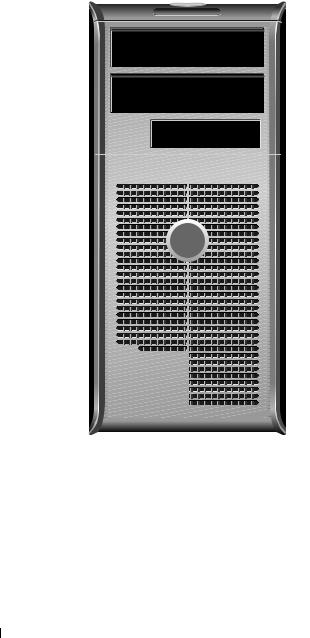
System Views
Mini Tower Computer — Front View
|
1 |
|
2 |
|
3 |
11 |
4 |
|
|
10 |
5 |
|
|
|
6 |
9 |
7 |
|
8 |
8 Quick Reference Guide

1 |
5.25-inch drive bay |
Can contain an optical drive. Insert a CD or DVD (if supported) into this drive. |
2 |
5.25-inch drive bay |
Can contain an optical drive. Insert a CD or DVD (if supported) into this drive. |
3 |
3.5-inch drive bay |
Can contain an optional floppy drive or optional media card reader. |
4 |
USB 2.0 connectors (2) |
Use the front USB connectors for devices that you connect occasionally, such as |
|
|
joysticks or cameras, or for bootable USB devices (see your online User’s Guide for |
|
|
more information on booting to a USB device). |
|
|
It is recommended that you use the back USB connectors for devices that typically |
|
|
remain connected, such as printers and keyboards. |
5 |
LAN indicator light |
This light indicates that a LAN (local area network) connection is established. |
6 |
diagnostic lights |
Use the lights to help you troubleshoot a computer problem based on the diagnostic |
|
|
code. For more information, see "Diagnostic Lights" on page 50. |
7 |
power button |
Press this button to turn on the computer. |
|
|
NOTICE: To avoid losing data, do not turn off the computer by pressing the power |
|
|
button. Instead, perform an operating system shutdown. See "Before You Begin" on |
|
|
page 25 for more information. |
|
|
NOTICE: If your operating system has ACPI enabled, when you press the power |
|
|
button the computer will perform an operating system shutdown. |
8 |
power light |
The power light illuminates and blinks or remains solid to indicate different operating |
|
|
modes: |
|
|
• No light — The computer is turned off. |
|
|
• Steady green — The computer is in a normal operating state. |
|
|
• Blinking green — The computer is in a power-saving mode. |
|
|
• Blinking or solid amber — See your online User’s Guide. |
|
|
To exit from a power-saving mode, press the power button or use the keyboard or the |
|
|
mouse if it is configured as a wake device in the Windows Device Manager. For more |
|
|
information about sleep modes and exiting from a power-saving mode, see your online |
|
|
User’s Guide. |
|
|
See "System Lights" on page 49 for a description of light codes that can help you |
|
|
troubleshoot problems with your computer. |
9 |
hard-drive activity light |
This light flickers when the hard drive is being accessed. |
10 |
headphone connector |
Use the headphone connector to attach headphones and most kinds of speakers. |
11 |
microphone connector |
Use the microphone connector to attach a microphone. |
Quick Reference Guide |
|
9 |
|
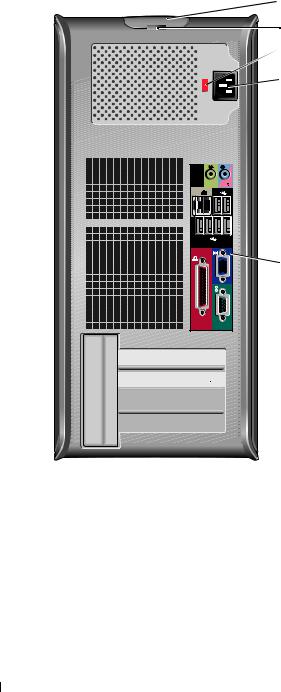
Mini Tower Computer — Back View
 1
1
2  3
3
 4
4
5 |

 6
6
|
|
|
|
1 |
cover-release latch |
This latch allows you to open the computer cover. |
|
2 |
padlock ring |
Insert a padlock to lock the computer cover. |
|
10 Quick Reference Guide

3 |
voltage selection switch |
Your computer is equipped with a manual voltage-selection switch. |
|
|
To help avoid damaging a computer with a manual voltage-selection switch, set the |
|
|
switch for the voltage that most closely matches the AC power available in your |
|
|
location. |
|
|
NOTICE: The voltage selection switch must be set to the 115-V position even |
|
|
though the AC power available in Japan is 100 V. |
|
|
Also, ensure that your monitor and attached devices are electrically rated to operate |
|
|
with the AC power available in your location. |
4 |
power connector |
Insert the power cable. |
5 |
back-panel connectors |
Plug serial, USB, and other devices into the appropriate connectors (see "Mini |
|
|
Tower Computer — Back-Panel Connectors" on page 11). |
6 |
card slots |
Access connectors for any installed PCI and PCI Express cards. |
Mini Tower Computer — Back-Panel Connectors
|
1 |
2 |
3 |
4 |
|
|
|
|
5 |
|
|
|
|
6 |
9 |
8 |
|
|
7 |
1 |
parallel connector |
Connect a parallel device, such as a printer, to the parallel connector. If you have a |
|
|
USB printer, plug it into a USB connector. |
|
|
NOTE: The integrated parallel connector is automatically disabled if the computer |
|
|
detects an installed card containing a parallel connector configured to the same |
|
|
address. For more information, see your online User’s Guide. |
2 |
link integrity light |
• Green — A good connection exists between a 10-Mbps network and the |
|
|
computer. |
•Orange — A good connection exists between a 100-Mbps network and the computer.
•Yellow — A good connection exists between a 1-Gbps (or 1000-Mbps) network and the computer.
•Off — The computer is not detecting a physical connection to the network.
Quick Reference Guide |
|
11 |
|

3 |
network adapter |
To attach your computer to a network or broadband device, connect one end of a |
|
connector |
network cable to either a network jack or your network or broadband device. |
|
|
Connect the other end of the network cable to the network adapter connector on |
|
|
the back panel of your computer. A click indicates that the network cable has been |
|
|
securely attached. |
|
|
NOTE: Do not plug a telephone cable into the network connector. |
|
|
On computers with a network connector card, use the connector on the card. |
|
|
It is recommended that you use Category 5 wiring and connectors for your |
|
|
network. If you must use Category 3 wiring, force the network speed to 10 Mbps to |
|
|
ensure reliable operation. |
4 |
network activity light |
Flashes a yellow light when the computer is transmitting or receiving network |
|
|
data. A high volume of network traffic may make this light appear to be in a steady |
|
|
"on" state. |
5 |
line-out connector |
Use the green line-out connector to attach most speakers with integrated |
|
|
amplifiers. |
6 |
line-in/microphone |
Use the blue and pink line-in/microphone connector to attach a record/playback |
|
connector |
device such as a cassette player, CD player, or VCR.; or a personal computer |
|
|
microphone for voice or musical input into a sound or telephony program. |
7 |
USB 2.0 connectors (6) |
Use the back USB connectors for devices that typically remain connected, such as |
|
|
printers and keyboards. |
8 |
video connector |
Plug the cable from your VGA-compatible monitor into the blue connector. |
|
|
NOTE: If you purchased an optional graphics card, this connector will be covered by |
|
|
a cap. Connect your monitor to the connector on the graphics card. Do not remove |
|
|
the cap. |
|
|
NOTE: If you are using a graphics card that supports dual monitors, use the y-cable |
|
|
that came with your computer. |
9 |
serial connector |
Connect a serial device, such as a handheld device, to the serial port. The default |
|
|
designations are COM1 for serial connector 1 and COM2 for serial connector 2. |
For more information, see your online User’s Guide.
12 Quick Reference Guide
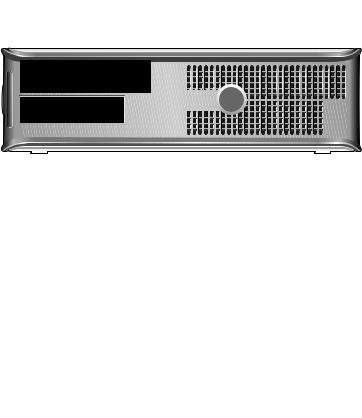
Desktop Computer — Front View
1 |
2 |
3 |
|
|
|||||||||
|
|
|
|
|
|
|
|
|
|
|
|
|
|
|
|
|
|
|
|
|
|
|
|
|
|
|
|
|
|
|
|
|
|
|
|
|
|
|
|
|
|
|
|
|
|
|
|
|
|
|
|
|
|
|
|
|
|
|
|
|
|
|
|
|
|
|
|
|
|
|
|
|
|
|
|
|
|
|
|
|
|
|
|
|
|
|
|
|
|
|
|
|
|
|
|
|
|
|
|
|
|
|
|
|
|
|
|
|
|
|
|
|
|
|
|
|
|
|
|
|
|
|
|
|
|
|
|
|
|
|
|
|
|
|
|
|
|
|
|
|
|
|
|
|
|
|
|
|
|
|
|
|
|
|
|
|
|
|
|
|
|
|
|
|
|
|
|
|
|
|
|
|
|
|
|
|
|
|
|
|
|
|
11 |
10 |
9 |
8 |
7 |
6 |
5 |
4 |
1 |
USB 2.0 connectors (2) |
Use the front USB connectors for devices that you connect occasionally, such as |
||||||
|
|
|
joysticks or cameras, or for bootable USB devices (see your online User’s Guide for |
|||||
|
|
|
more information about booting to a USB device). |
|||||
|
|
|
It is recommended that you use the back USB connectors for devices that typically |
|||||
|
|
|
remain connected, such as printers and keyboards. |
|||||
2 |
LAN indicator light |
|
This light indicates that a LAN (local area network) connection is established. |
|||||
3 |
power button |
|
Press this button to turn on the computer. |
|
||||
|
|
|
NOTICE: To avoid losing data, do not turn off the computer by pressing the |
|||||
|
|
|
power button. Instead, perform an operating system shutdown. See "Before You |
|||||
|
|
|
Begin" on page 25 for more information. |
|
||||
|
|
|
NOTICE: If your operating system has ACPI enabled, when you press the |
|||||
|
|
|
power button the computer will perform an operating system shutdown. |
|||||
4 |
Dell badge |
|
This badge can be rotated to match the orientation of your computer. To rotate, |
|||||
|
|
|
place fingers around the outside of the badge, press firmly, and turn the badge. You |
|||||
|
|
|
can also rotate the badge using the slot provided near the bottom of the badge. |
|||||
Quick Reference Guide |
|
13 |
|
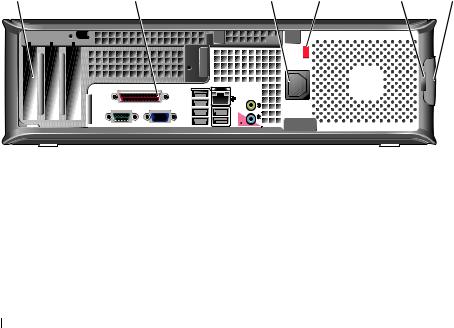
5 |
power light |
|
The power light illuminates and blinks or remains solid to indicate different |
|||||||||||
|
|
|
|
operating states: |
|
|
|
|
||||||
|
|
|
|
• No light — The computer is turned off. |
|
|
|
|||||||
|
|
|
|
• Steady green — The computer is in a normal operating state. |
|
|||||||||
|
|
|
|
• Blinking green — The computer is in a power-saving mode. |
|
|||||||||
|
|
|
|
• Blinking or solid amber — See your online User’s Guide. |
|
|||||||||
|
|
|
|
To exit from a power-saving mode, press the power button or use the keyboard or |
||||||||||
|
|
|
|
the mouse if it is configured as a wake device in the Windows Device Manager. For |
||||||||||
|
|
|
|
more information about sleep modes and exiting from a power-saving mode, see |
||||||||||
|
|
|
|
your online User’s Guide. |
|
|
|
|
||||||
|
|
|
|
See "System Lights" on page 49 for a description of light codes that can help you |
||||||||||
|
|
|
|
troubleshoot problems with your computer. |
|
|
|
|||||||
6 |
diagnostic lights |
|
Use the lights to help you troubleshoot a computer problem based on the |
|||||||||||
|
|
|
|
diagnostic code. For more information, see "Diagnostic Lights" on page 50. |
||||||||||
7 |
hard-drive activity light |
|
This light flickers when the hard drive is being accessed. |
|
||||||||||
8 |
headphone connector |
|
Use the headphone connector to attach headphones and most kinds of speakers. |
|||||||||||
9 |
microphone connector |
|
Use the microphone connector to attach a microphone. |
|
||||||||||
10 |
3.5-inch drive bay |
|
Can contain an optional floppy drive or optional Media Card Reader. |
|||||||||||
11 |
5.25-inch drive bay |
|
Can contain an optical drive. Insert a CD or DVD (if supported) into this drive. |
|||||||||||
Desktop Computer — Back View |
|
|
|
|
||||||||||
|
1 |
|
2 |
3 |
4 |
5 |
|
6 |
||||||
|
|
|
|
|
|
|
|
|
|
|
|
|
|
|
|
|
|
|
|
|
|
|
|
|
|
|
|
|
|
|
|
|
|
|
|
|
|
|
|
|
|
|
|
|
|
|
|
|
|
|
|
|
|
|
|
|
|
|
|
|
|
|
|
|
|
|
|
|
|
|
|
|
|
|
|
|
|
|
|
|
|
|
|
|
|
|
|
|
|
|
|
|
|
|
|
|
|
|
|
|
|
|
|
|
|
|
|
|
|
|
|
|
|
|
|
|
|
|
|
|
|
|
|
|
|
|
|
|
|
|
|
|
|
|
14 Quick Reference Guide

1 |
card slots |
Access connectors for any installed PCI and PCI Express cards. |
2 |
back-panel connectors |
Plug serial, USB, and other devices into the appropriate connectors (see "Desktop |
|
|
Computer — Back-Panel Connectors" on page 15). |
3 |
power connector |
Insert the power cable. |
4 |
voltage selection switch |
Your computer is equipped with a manual voltage selection switch. |
|
|
To help avoid damaging a computer with a manual voltage selection switch, set |
|
|
the switch for the voltage that most closely matches the AC power available in |
|
|
your location. |
|
|
NOTICE: The voltage selection switch must be set to the 115-V position even |
|
|
though the AC power available in Japan is 100 V. |
|
|
Also, ensure that your monitor and attached devices are electrically rated to |
|
|
operate with the AC power available in your location. |
5 |
padlock ring |
Insert a padlock to lock the computer cover. |
6 |
cover-release latch |
Allows you to open the computer cover. |
Desktop Computer — Back-Panel Connectors
|
1 |
2 |
3 |
4 |
|
|
|
|
5 |
|
|
|
|
6 |
9 |
8 |
|
|
7 |
Quick Reference Guide |
|
15 |
|

1 |
parallel connector |
Connect a parallel device, such as a printer, to the parallel connector. If you have a |
|
|
USB printer, plug it into a USB connector. |
|
|
NOTE: The integrated parallel connector is automatically disabled if the computer |
|
|
detects an installed card containing a parallel connector configured to the same |
|
|
address. For more information, see your online User’s Guide. |
2 |
link integrity light |
• Green — A good connection exists between a 10-Mbps network and the |
|
|
computer. |
|
|
• Orange — A good connection exists between a 100-Mbps network and the |
|
|
computer. |
|
|
• Yellow — A good connection exists between a 1-Gbps (or 1000-Mbps) network |
|
|
and the computer. |
|
|
• Off — The computer is not detecting a physical connection to the network. |
3 |
network adapter |
To attach your computer to a network or broadband device, connect one end of a |
|
connector |
network cable to either a network jack or your network or broadband device. |
|
|
Connect the other end of the network cable to the network adapter connector on |
|
|
the back panel of your computer. A click indicates that the network cable has been |
|
|
securely attached. |
|
|
NOTE: Do not plug a telephone cable into the network connector. |
|
|
On computers with a network connector card, use the connector on the card. |
|
|
It is recommended that you use Category 5 wiring and connectors for your |
|
|
network. If you must use Category 3 wiring, force the network speed to 10 Mbps to |
|
|
ensure reliable operation. |
4 |
network activity light |
Flashes a yellow light when the computer is transmitting or receiving network |
|
|
data. A high volume of network traffic may make this light appear to be in a steady |
|
|
"on" state. |
5 |
line-out connector |
Use the green line-out connector to attach most speakers with integrated |
|
|
amplifiers. |
6 |
line-in/microphone |
Use the blue and pink line-in/microphone connector to attach a record/playback |
|
connector |
device such as a cassette player, CD player, or VCR.; or a personal computer |
|
|
microphone for voice or musical input into a sound or telephony program. |
7 |
USB 2.0 connectors (6) |
Use the back USB connectors for devices that typically remain connected, such as |
|
|
printers and keyboards. |
8 |
video connector |
Plug the cable from your VGA-compatible monitor into the blue connector. |
|
|
NOTE: If you purchased an optional graphics card, this connector will be covered by |
|
|
a cap. Connect your monitor to the connector on the graphics card. Do not remove |
|
|
the cap. |
|
|
NOTE: If you are using a graphics card that supports dual monitors, use the y-cable |
|
|
that came with your computer. |
9 |
serial connector |
Connect a serial device, such as a handheld device, to the serial port. The default |
|
|
designations are COM1 for serial connector 1 and COM2 for serial connector 2. |
For more information, see your online User’s Guide.
16 Quick Reference Guide

Small Form Factor Computer — Front View
1 |
2 |
3 |
4
 5
5
|
|
|
|
|
6 |
|
11 |
10 |
9 |
8 |
7 |
1 |
USB 2.0 connectors (2) |
Use the front USB connectors for devices that you connect occasionally, such as |
|||
|
|
|
joysticks or cameras, or for bootable USB devices (see your online User’s Guide for |
||
|
|
|
more information about booting to a USB device). |
||
|
|
|
It is recommended that you use the back USB connectors for devices that typically |
||
|
|
|
remain connected, such as printers and keyboards. |
||
2 |
power button |
|
Press to turn on the computer. |
||
|
|
|
NOTICE: To avoid losing data, do not turn off the computer by pressing the |
||
|
|
|
power button. Instead, perform an operating system shutdown. See "Before You |
||
|
|
|
Begin" on page 25 for more information. |
||
|
|
|
NOTICE: If your operating system has ACPI enabled, when you press the |
||
|
|
|
power button the computer will perform an operating system shutdown. |
||
3 |
Dell badge |
|
Can be rotated to match the orientation of your computer. To rotate, place fingers |
||
|
|
|
around the outside of the badge, press firmly, and turn the badge. You can also |
||
|
|
|
rotate the badge using the slot provided near the bottom of the badge. |
||
4 |
LAN indicator light |
Indicates that a LAN (local area network) connection is established. |
|||
5 |
diagnostic lights |
|
Use the lights to help you troubleshoot a computer problem based on the |
||
|
|
|
diagnostic code. For more information, see "Diagnostic Lights" on page 50. |
||
6 |
hard drive activity light |
This light flickers when the hard drive is being accessed. |
|||
Quick Reference Guide |
|
17 |
|
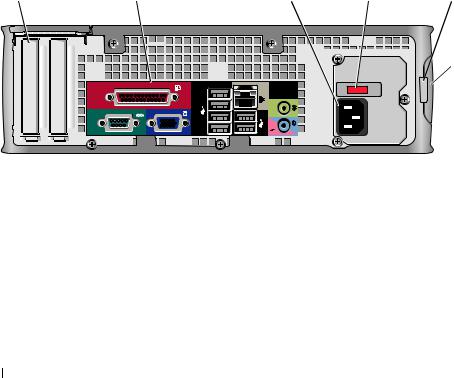
7 |
power light |
|
The power light illuminates and blinks or remains solid to indicate different |
||
|
|
|
operating states: |
|
|
|
|
|
• No light — The computer is turned off. |
|
|
|
|
|
• Steady green — The computer is in a normal operating state. |
|
|
|
|
|
• Blinking green — The computer is in a power-saving mode. |
|
|
|
|
|
• Blinking or solid amber — See your online User’s Guide. |
|
|
|
|
|
To exit from a power-saving mode, press the power button or use the keyboard or |
||
|
|
|
the mouse if it is configured as a wake device in the Windows Device Manager. For |
||
|
|
|
more information about sleep modes and exiting from a power-saving mode, see |
||
|
|
|
your online User’s Guide. |
|
|
|
|
|
See "System Lights" on page 49 for a description of light codes that can help you |
||
|
|
|
troubleshoot problems with your computer. |
|
|
8 |
headphone connector |
|
Use the headphone connector to attach headphones and most kinds of speakers. |
||
9 |
microphone connector |
|
Use the microphone connector to attach a microphone. |
|
|
10 |
3.5-inch drive bay |
|
Can contain an optional floppy drive or optional media card reader. |
||
11 |
5.25-inch drive bay |
|
Can contain an optical drive. Insert a CD or DVD (if supported) into this drive. |
||
Small Form Factor Computer — Back View |
|
|
|||
|
1 |
2 |
3 |
4 |
5 |
 6
6
18 Quick Reference Guide
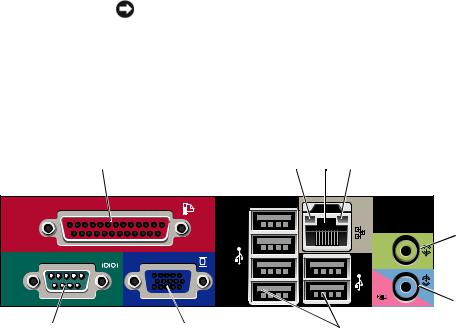
1 |
card slots |
Access connectors for any installed PCI and PCI Express cards. |
2 |
back-panel connectors |
Plug serial, USB, and other devices into the appropriate connectors (see "Small |
|
|
Form Factor Computer — Back-Panel Connectors" on page 19). |
3 |
power connector |
Insert the power cable. |
4 |
voltage selection switch |
Your computer is equipped with a manual voltage-selection switch. |
|
|
To help avoid damaging a computer with a manual voltage selection switch, set |
|
|
the switch for the voltage that most closely matches the AC power available in |
|
|
your location. |
|
|
NOTICE: The voltage selection switch must be set to the 115-V position even |
|
|
though the AC power available in Japan is 100 V. |
|
|
Also, ensure that your monitor and attached devices are electrically rated to |
|
|
operate with the AC power available in your location. |
5 |
padlock ring |
Insert a padlock to lock the computer cover. |
6 |
cover release latch |
Allows you to open the computer cover. |
Small Form Factor Computer — Back-Panel Connectors
|
1 |
2 |
3 |
4 |
|
|
|
|
5 |
|
|
|
|
6 |
9 |
8 |
|
|
7 |
Quick Reference Guide |
|
19 |
|

1 |
parallel connector |
Connect a parallel device, such as a printer, to the parallel connector. If you have a |
|
|
USB printer, plug it into a USB connector. |
|
|
NOTE: The integrated parallel connector is automatically disabled if the computer |
|
|
detects an installed card containing a parallel connector configured to the same |
|
|
address. For more information, see your online User’s Guide. |
2 |
link integrity light |
• Green — A good connection exists between a 10-Mbps network and the |
|
|
computer. |
|
|
• Orange — A good connection exists between a 100-Mbps network and the |
|
|
computer. |
|
|
• Yellow — A good connection exists between a 1-Gbps (or 1000-Mbps) network |
|
|
and the computer. |
|
|
• Off — The computer is not detecting a physical connection to the network. |
3 |
network adapter |
To attach your computer to a network or broadband device, connect one end of a |
|
connector |
network cable to either a network jack or your network or broadband device. |
|
|
Connect the other end of the network cable to the network adapter connector on |
|
|
the back panel of your computer. A click indicates that the network cable has been |
|
|
securely attached. |
|
|
NOTE: Do not plug a telephone cable into the network connector. |
|
|
On computers with a network connector card, use the connector on the card. |
|
|
It is recommended that you use Category 5 wiring and connectors for your |
|
|
network. If you must use Category 3 wiring, force the network speed to 10 Mbps to |
|
|
ensure reliable operation. |
4 |
network activity light |
Flashes a yellow light when the computer is transmitting or receiving network |
|
|
data. A high volume of network traffic may make this light appear to be in a steady |
|
|
"on" state. |
5 |
line-out connector |
Use the green line-out connector (available on computers with integrated sound) |
|
|
to attach most speakers with integrated amplifiers. |
6 |
line-in/microphone |
Use the blue and pink line-in/microphone connector (available on computers with |
|
connector |
integrated sound) to attach a record/playback device such as a cassette player, CD |
|
|
player, or VCR; or a personal computer microphone for voice or musical input into |
|
|
a sound or telephony program. |
7 |
USB 2.0 connectors (6) |
Use the back USB connectors for devices that typically remain connected, such as |
|
|
printers and keyboards. |
20 Quick Reference Guide
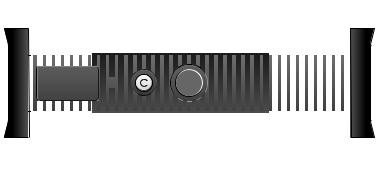
8 |
video connector |
Plug the cable from your VGA-compatible monitor into the blue connector. |
|
|
NOTE: If you purchased an optional graphics card, this connector will be covered by |
|
|
a cap. Connect your monitor to the connector on the graphics card. Do not remove |
|
|
the cap. |
|
|
NOTE: If you are using a graphics card that supports dual monitors, use the y-cable |
|
|
that came with your computer. |
9 |
serial connector |
Connect a serial device, such as a handheld device, to the serial port. The default |
|
|
designations are COM1 for serial connector 1 and COM2 for serial connector 2. |
For more information, see your online User’s Guide.
Ultra-Small Form Factor Computer — Front View
1 |
2 |
3 |
4 |
5 |
|
|
|
|
|
|
|
|
|
|
|
|
|
|
||||||||||||||||||||
|
|
|
|
|
|
|
|
|
|
|
|
|
|
|
|
|
|
|
|
|
|
|
|
|
|
|
|
|
|
|
|
|
|
|
|
|
|
|
|
|
|
|
|
|
|
|
|
|
|
|
|
|
|
|
|
|
|
|
|
|
|
|
|
|
|
|
|
|
|
|
|
|
|
|
|
|
|
|
|
|
|
|
|
|
|
|
|
|
|
|
|
|
|
|
|
|
|
|
|
|
|
|
|
|
|
|
|
|
|
|
|
|
|
|
|
|
|
|
|
|
|
|
|
|
|
|
|
|
|
|
|
|
|
|
|
|
|
|
|
|
|
|
|
|
|
|
|
|
|
|
|
|
|
|
|
|
|
|
|
|
|
|
|
|
|
|
|
|
|
|
|
|
|
|
|
|
|
|
|
|
|
|
|
|
|
|
|
|
|
|
|
|
|
|
|
|
|
|
|
|
|
|
|
|
|
|
|
|
|
|
|
|
|
|
|
|
|
|
|
|
|
|
|
|
|
|
|
|
|
|
|
|
|
|
|
|
|
|
|
|
|
|
|
|
|
|
|
|
|
|
|
|
|
|
|
|
|
|
|
|
|
|
|
|
|
|
|
|
|
|
|
|
|
|
|
|
|
|
|
|
|
|
|
|
|
|
|
|
|
|
|
|
|
|
|
|
|
|
|
|
|
|
|
|
|
|
|
|
|
|
|
|
|
|
|
|
|
|
|
|
|
|
|
|
|
|
|
|
|
|
|
|
|
|
|
|
|
|
|
|
|
|
|
|
|
|
|
|
|
|
|
|
|
|
|
|
|
|
|
|
|
|
|
|
|
|
|
|
|
|
|
|
|
|
|
|
|
|
|
|
|
|
|
|
|
|
|
|
|
|
|
|
|
|
|
|
|
|
|
|
|
|
|
|
|
|
|
|
|
|
|
|
|
|
|
|
|
|
|
|
|
|
|
|
|
|
|
|
|
|
|
|
|
|
|
|
|
|
|
|
|
|
|
|
|
|
|
|
|
|
|
|
|
|
|
|
|
|
|
|
|
|
|
|
|
|
|
|
|
|
|
|
|
|
|
|
|
|
|
|
|
|
|
|
|
|
|
|
|
|
|
|
|
|
|
|
|
|
|
|
|
|
|
|
|
|
|
|
|
|
|
|
|
|
|
|
|
|
|
|
|
|
|
|
|
|
|
|
|
|
|
|
|
|
|
|
|
|
|
|
|
|
|
|
|
|
|
|
|
|
|
|
|
|
|
|
|
|
|
|
|
|
|
|
|
|
|
|
|
|
|
|
|
|
|
|
|
|
|
|
|
|
|
|
|
|
|
|
|
|
|
|
|
|
|
|
|
|
|
|
|
|
|
|
|
|
|
|
|
|
|
|
|
|
|
|
|
|
|
|
|
|
|
|
|
|
|
|
|
|
|
|
|
|
|
|
|
|
|
|
|
|
|
|
|
|
|
|
|
|
|
|
|
|
|
|
|
|
|
|
|
|
|
|
|
|
|
|
|
|
|
|
|
|
|
|
|
|
|
|
|
|
|
|
|
|
|
|
|
|
|
|
|
|
|
|
|
|
|
|
|
|
9 |
8 |
7 |
6 |
1 |
USB connectors (2) |
Use the front USB connectors for devices that you connect occasionally, such as |
||
|
|
joysticks or cameras, or for bootable USB devices (see your online User’s Guide for |
||
|
|
more information about booting to a USB device). |
|
|
|
|
It is recommended that you use the back USB connectors for devices that typically |
||
|
|
remain connected, such as printers and keyboards. |
|
|
2 |
headphone connector |
Use the headphone connector to attach headphones and most kinds of speakers. |
||
3 |
microphone connector |
Use the microphone connector to attach a microphone. |
||
Quick Reference Guide |
|
21 |
|
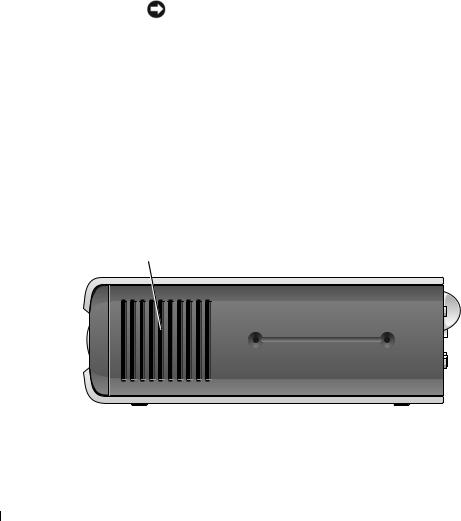
4 |
power light |
The power light illuminates and blinks or remains solid to indicate different states: |
|
|
• No light — The computer is turned off. |
|
|
• Steady green — The computer is in a normal operating state. |
|
|
• Blinking green — The computer is in a power-saving mode. |
|
|
• Blinking or solid yellow — See your online User’s Guide. |
|
|
To exit from a power-saving mode, press the power button or use the keyboard or |
|
|
the mouse if it is configured as a wake device in the Windows Device Manager. For |
|
|
more information about sleep modes and exiting from a power-saving mode, see |
|
|
your online User’s Guide. |
|
|
See "System Lights" on page 49 for a description of light codes that can help you |
|
|
troubleshoot problems with your computer. |
5 |
power button |
Press this button to turn on the computer. |
|
|
NOTICE: To avoid losing data, do not turn off the computer by pressing the |
|
|
power button. Instead, perform an operating system shutdown. See "Before You |
|
|
Begin" on page 25 for more information. |
6 |
vents |
The vents help prevent your computer from overheating. To ensure proper |
|
|
ventilation, do not block these cooling vents. |
7 |
module bay |
Install a D-module optical drive, second hard drive, or floppy drive in the module |
|
|
bay. |
8 |
hard-drive access light |
The hard-drive access light is on when the computer reads data from or writes data |
|
|
to the hard drive. The light might also be on when devices such as your CD player |
|
|
are operating. |
9 |
vents |
The vents help prevent your computer from overheating. To ensure proper |
|
|
ventilation, do not block these cooling vents. |
Ultra-Small Form Factor Computer — Side View
1
1 |
vents |
The vents located on each side of the computer help prevent your computer from |
|
|
overheating. To ensure proper ventilation, do not block these cooling vents. |
22 Quick Reference Guide

Ultra-Small Form Factor Computer — Back View
1 |
2 |
|
|
|
3 |
|
|
|
|
|
|
|
|
|
|
|
|
|
|
|
|
|
|
|
|
|
|
|
|
|
|
|
|
|
|
|
|
|
|
|
|
|
|
|
|
|
|
|
|
|
|
|
|
|
|
|
|
|
|
|
|
|
|
|
|
|
|
|
|
|
|
|
|
|
|
|
|
|
|
|
|
|
|
|
|
|
|
|
|
|
|
|
|
|
|
|
|
|
|
|
|
|
|
|
|
|
|
|
|
|
|
|
|
|
|
|
|
|
|
|
|
5 |
4 |
1 |
diagnostic lights |
See "Diagnostic Lights" on page 50 for a description of light codes |
|
|
that can help you troubleshoot problems with your computer. |
2 |
computer cover release knob |
Rotate this knob in a clockwise direction to remove the cover. |
3 |
back-panel connectors |
The connectors for your computer (see "Ultra-Small Form Factor |
|
|
Computer — Back-Panel Connectors" on page 23). |
4 |
power connector |
Insert the power cable. |
5 |
vents |
The vents help prevent your computer from overheating. To ensure |
|
|
proper ventilation, do not block these cooling vents. |
Ultra-Small Form Factor Computer — Back-Panel Connectors
1 2 3 4
|
|
|
|
|
5 |
|
|
|
|
|
6 |
|
11 |
10 |
9 |
8 |
7 |
1 |
parallel connector |
Connect a parallel device, such as a printer, to the parallel connector. If you have a USB |
|||
|
|
|
printer, plug it into a USB connector. |
|
|
Quick Reference Guide |
|
23 |
|

2 |
link integrity light |
• Green — A good connection exists between a 10-Mbps network and the computer. |
|
|
• Orange — A good connection exists between a 100-Mbps network and the computer. |
|
|
• Yellow — A good connection exists between a 1000-Mbps (1-Gbps) network and the |
|
|
computer. |
|
|
• Off — The computer is not detecting a physical connection to the network or the |
|
|
network controller is turned off in system setup. |
3 |
network adapter |
To attach your computer to a network or broadband device, connect one end of a |
|
|
network cable to either a network jack or your network or broadband device. Connect |
|
|
the other end of the network cable to the network adapter connector on the back panel |
|
|
of your computer. A click indicates that the network cable has been securely attached. |
|
|
NOTE: Do not plug a telephone cable into the network connector. |
|
|
On computers with a network connector card, use the connector on the card. |
|
|
It is recommended that you use Category 5 wiring and connectors for your network. If |
|
|
you must use Category 3 wiring, force the network speed to 10 Mbps to ensure reliable |
|
|
operation. |
4 |
network activity light |
The amber light flashes when the computer is transmitting or receiving network data. A |
|
|
high volume of network traffic may make this light appear to be in a steady "on" state. |
5line-out connector
6line-in/ microphone connector
Use the green line-out connector to attach an amplified speaker set.
Use the blue and pink line-in/ microphone connector to attach a record/playback device such as a cassette player, CD player, or VCR.; or a personal computer microphone for voice or musical input into a sound or telephony program.
7 |
USB connectors (5) |
Use the back USB connectors for devices that typically remain connected, such as |
|
|
printers and keyboards. |
8 |
serial connector |
Connect a serial device, such as a handheld device, to the serial connector. |
9 |
video connector |
If you have a DVI-compatible monitor, plug the cable from your monitor into the white |
|
|
connector on the back panel. |
|
|
If you have a VGA monitor, see "Connecting a VGA Monitor" in your computer User’s |
|
|
Guide. |
10 |
power connector |
The connector for the power adapter. |
11 |
diagnostic lights |
See "Diagnostic Lights" on page 50 for a description of light codes that can help you |
|
|
troubleshoot problems with your computer. |
Removing the Computer Cover
CAUTION: Before you begin any of the procedures in this section, follow the safety instructions in the Product Information Guide.
CAUTION: To guard against electrical shock, always unplug your computer from the electrical outlet before removing the cover.
24 Quick Reference Guide

Before You Begin
NOTICE: To avoid losing data, save and close any open files and exit any open programs before you turn off your computer.
1Shut down the operating system:
a Save and close any open files, exit any open programs, click the Start button, and then click Turn Off Computer.
b In the Turn off computer window, click Turn off.
The computer turns off after the operating system shutdown process finishes.
2Ensure that the computer and any attached devices are turned off. If your computer and attached devices did not automatically turn off when you shut down your operating system, turn them off now.
Before Working Inside Your Computer
Use the following safety guidelines to help protect your computer from potential damage and to help ensure your own personal safety.
CAUTION: Before you begin any of the procedures in this section, follow the safety instructions in the Product Information Guide.
CAUTION: Handle components and cards with care. Do not touch the components or contacts on a card. Hold a card by its edges or by its metal mounting bracket. Hold a component such as a processor by its edges, not by its pins.
NOTICE: Only a certified service technician should perform repairs on your computer. Damage due to servicing that is not authorized by Dell is not covered by your warranty.
NOTICE: When you disconnect a cable, pull on its connector or on its strain-relief loop, not on the cable itself. Some cables have a connector with locking tabs; if you are disconnecting this type of cable, press in on the locking tabs before you disconnect the cable. As you pull connectors apart, keep them evenly aligned to avoid bending any connector pins. Also, before you connect a cable, ensure that both connectors are correctly oriented and aligned.
To avoid damaging the computer, perform the following steps before you begin working inside the computer.
1 Turn off your computer.
NOTICE: To disconnect a network cable, first unplug the cable from your computer and then unplug it from the network wall jack.
2Disconnect any telephone or telecommunication lines from the computer.
3Disconnect your computer and all attached devices from their electrical outlets, and then press the power button to ground the system board.
4If applicable, remove the computer stand (for instructions, see the documentation that came with the stand).
CAUTION: To guard against electrical shock, always unplug your computer from the electrical outlet before removing the cover.
Quick Reference Guide |
|
25 |
|

5Remove the computer cover:
•Remove the mini tower computer cover (see "Mini Tower Computer" on page 26).
•Remove the desktop computer cover (see "Desktop Computer" on page 27).
•Remove the small form factor computer cover (see "Small Form Factor Computer" on page 28).
•Remove the ultra-small form factor computer cover (see "Ultra-Small Form Factor Computer" on page 30).
NOTICE: Before touching anything inside your computer, ground yourself by touching an unpainted metal surface, such as the metal at the back of the computer. While you work, periodically touch an unpainted metal surface to dissipate any static electricity that could harm internal components.
Mini Tower Computer
CAUTION: Before you begin any of the procedures in this section, follow the safety instructions in the Product Information Guide.
CAUTION: To guard against electrical shock, always unplug your computer from the electrical outlet before removing the computer cover.
1Follow the procedures in "Before You Begin" on page 25.
2Lay the computer on its side as shown in the illustration.
3Locate the cover release latch shown in the illustration. Then, slide the release latch back as you lift the cover.
4Grip the sides of the computer cover and pivot the cover up using the hinge tabs as leverage points.
5Remove the cover from the hinge tabs and set it aside on a soft nonabrasive surface.
CAUTION: Graphic card heatsinks may become very hot during normal operation. Ensure that a graphic card heatsink has had sufficient time to cool before you touch it.
26 Quick Reference Guide
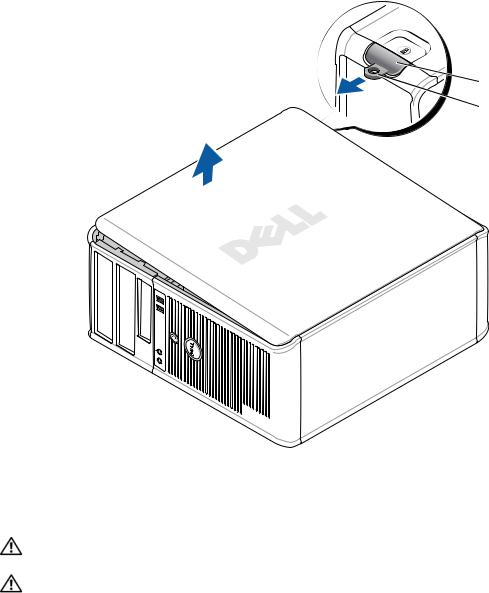

 1
1
 2
2
 3
3
1 security cable slot |
2 cover release latch |
3 padlock ring |
Desktop Computer
CAUTION: Before you begin any of the procedures in this section, follow the safety instructions in the Product Information Guide.
CAUTION: To guard against electrical shock, always unplug your computer from the electrical outlet before removing the computer cover.
1Follow the procedures in "Before You Begin" on page 25.
2If you have installed a padlock through the padlock ring on the back panel, remove the padlock.
Quick Reference Guide |
|
27 |
|

3Locate the cover release latch shown in the illustration. Then, slide the release latch back as you lift the cover.
4Grip the sides of the computer cover and pivot the cover up using the hinge tabs as leverage points.
5Remove the cover from the hinge tabs and set it aside on a soft nonabrasive surface.
CAUTION: Graphic card heatsinks may become very hot during normal operation. Ensure that a graphic card heatsink has had sufficient time to cool before you touch it.

 1
1
 2
2
 3
3
1 security cable slot |
2 cover release latch |
3 padlock ring |
Small Form Factor Computer
CAUTION: Before you begin any of the procedures in this section, follow the safety instructions in the Product Information Guide.
CAUTION: To guard against electrical shock, always unplug your computer from the electrical outlet before removing the computer cover.
28 Quick Reference Guide
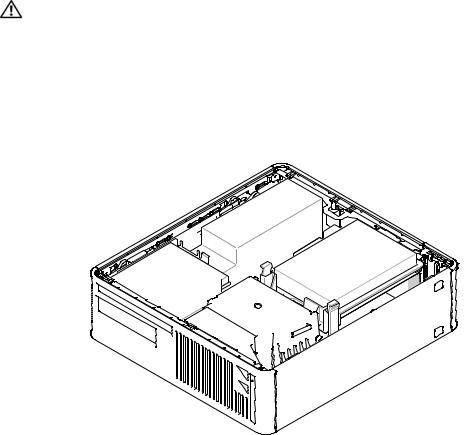
1Follow the procedures in "Before You Begin" on page 25.
2If you have installed a padlock through the padlock ring on the back panel, remove the padlock.
3Locate the cover release latch shown in the illustration. Then, slide the release latch back as you lift the cover.
4Grip the sides of the computer cover and pivot the cover up using the bottom hinges as leverage points.
5Remove the cover from the hinge tabs and set it aside on a soft nonabrasive surface.
CAUTION: Graphic card heatsinks may become very hot during normal operation. Ensure that a graphic card heatsink has had sufficient time to cool before you touch it.
|
1 |
3 |
2 |
|
1 security cable slot |
2 cover release latch |
3 computer cover |
Quick Reference Guide |
|
29 |
|
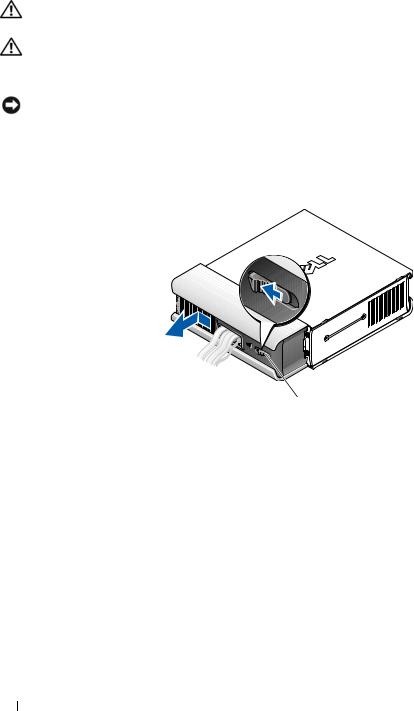
Ultra-Small Form Factor Computer
CAUTION: Before you begin any of the procedures in this section, follow the safety instructions in the Product Information Guide.
CAUTION: To guard against electrical shock, always unplug your computer from the electrical outlet before removing the computer cover.
1 Follow the procedures in "Before You Begin" on page 25.
NOTICE: Before touching anything inside your computer, ground yourself by touching an unpainted metal surface. While you work, periodically touch an unpainted metal surface to dissipate any static electricity that could harm internal components.
2If applicable, remove the cable cover.
a If a security device is installed in the security cable slot, remove the device.
 1
1
1 release button
bPress on the release button, grasp the cable cover, and slide the cover to the left until it stops, and then lift the cable cover up and away.
3Remove the computer cover:
a Rotate the cover release knob in a clockwise direction, as shown in the illustration.
b Slide the computer cover forward by 1 cm (½ inch), or until it stops, and then raise the cover.
30 Quick Reference Guide
